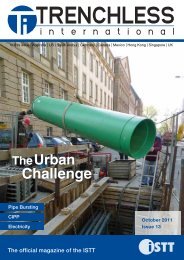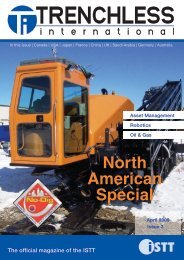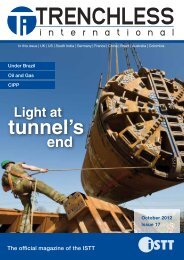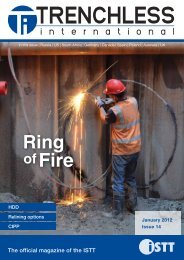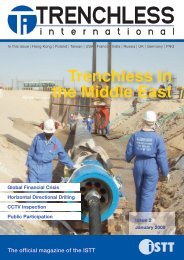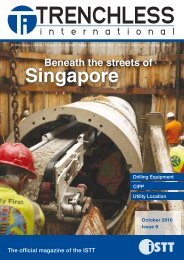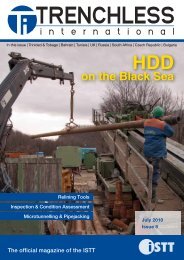Boring - Trenchless International
Boring - Trenchless International
Boring - Trenchless International
You also want an ePaper? Increase the reach of your titles
YUMPU automatically turns print PDFs into web optimized ePapers that Google loves.
DN150 liner installed and reverted.<br />
Reverted liners showing conformance<br />
inside bends.<br />
Hong Kong benefits from PE rehab<br />
by Jon Boon, Insituform<br />
Introducing a new pipeline rehabilitation system into a mature market is not easy. Even after extensive product<br />
development and testing to prove that the selected polymers, pipe processor and fittings being used meet project<br />
requirements, it is necessary to prove to potential clients that the system can withstand the rigours of rehabilitation<br />
in the field.<br />
New tee fitted on the DN150 liner.<br />
Both liners reverted. The upper part of<br />
the bends shown here was removed to<br />
expose the condition of the liner during<br />
and after re-rounding.<br />
Fully re-rounded pipe in test rig.<br />
Asset Management<br />
April 2010 - <strong>Trenchless</strong> <strong>International</strong><br />
In response to an Underground Asset<br />
Management Study in 1997, the Hong<br />
Kong SAR started the Replacement<br />
and Rehabilitation Programme of Water<br />
Mains with a view to improve about<br />
3,000 kilometres (40 per cent of the<br />
total pipeline network) of aged water<br />
mains. Since the start of the works, closefit<br />
polyethylene lining techniques have<br />
increasingly been used to rehabilitate<br />
water pipelines. This family of techniques<br />
involves insertion of a high-density polyethylene<br />
(HDPE) liner after temporarily<br />
reducing the cross section, either radially<br />
or by folding, to facilitate installation. The<br />
liner is then reverted/re-rounded, typically<br />
by pressurised water, air, steam or<br />
a combination of these methods.<br />
Insituform Asia Ltd. (Insituform) introduced<br />
InsituGuard, its close-fit HDPE<br />
lining system in 2007. Using two<br />
installation techniques, InsituFlex, a concentrically<br />
reduced pipe (CRP) system<br />
and InsituFold, a longitudinally folded<br />
pipe system, the system is fully structural<br />
by design, with an SDR of 17 providing<br />
a 10 bar pressure rating. The use of<br />
InsituGuard can significantly reduce the<br />
amount of trenching required and maintain<br />
or even enhance flows. Insituform<br />
looked closely at the key material properties<br />
of the lining systems in advance and<br />
confirmed that they met the key requirements<br />
within the European standard.<br />
The Insituflex system employs a radial<br />
reduction technology that temporarily<br />
reduces the liner’s diameter concentrically<br />
by as much as 20 per cent. A series of<br />
drive rollers pushes the pipe into place<br />
while also squeezing it to a smaller<br />
diameter. Rather than assert high pulling<br />
loads on the liner, a winch is used<br />
to pull the nose of the liner around<br />
bends and past dislocated joints. This<br />
process places less axial strain on the<br />
liner and leaves less residual tension<br />
in the final liner pipe system which<br />
consists of the liner, host pipe and fittings.<br />
This approach also helps minimise<br />
axial retraction of the pipe at the end<br />
pits during its return towards its original<br />
diameter. If the liner has to be cut<br />
into at a later time this reduced retraction<br />
makes the insertion of new fittings<br />
easier.<br />
The InsituFold system folds HDPE<br />
pipe into a “heart” shape, which reduces<br />
the cross-section of the liner by up to<br />
40 per cent. As it exits the machine, the<br />
folded liner is then banded to maintain<br />
the reduced shape prior to its insertion<br />
into the host pipe.<br />
These bands are broken by internally<br />
pressurising the pipe with water after<br />
insertion. As with the InsituFlex installation<br />
process, this helps ensure that there<br />
is less retraction if the pipe has to be cut<br />
into at a later time.<br />
Testing times<br />
In order to have the InsituGuard system<br />
approved a range of tests and trials were<br />
initiated. Some of these were to satisfy<br />
Insituform that the InsituGuard system<br />
did not have a deleterious effect on the<br />
performance of the pipes. Other tests<br />
InsituFold Liner.<br />
Tested sample collected from laboratory.<br />
were requested by the client to confirm<br />
that the system would meet contractual<br />
obligations.<br />
The InsituGuard liner has a pressure<br />
rating of PN10, which is classified as fully<br />
structural and independent according to<br />
the American Water Works Association<br />
(AWWA) and the European Committee<br />
for Standardization (CEN). The structural<br />
requirement of the liner is set to cope with<br />
the typical internal operating pressures<br />
found in Hong Kong water pipelines which<br />
range from 3 bar to 10 bar.<br />
The specifications for close fit lining<br />
systems require meeting a mixture of<br />
prescriptive and performance criteria. The<br />
reduction of flow capacity should not<br />
exceed 3 per cent. Any reduction in flow<br />
capacity due to loss in bore cross-sectional<br />
area due to the thickness of the liner<br />
is typically offset with the smoother inside<br />
surface of the HDPE liner. Pipe material<br />
quality is specified to meet international<br />
standards.<br />
Because customers have indicated<br />
they want a system that is repairable<br />
within the client’s water resumption<br />
performance pledge, an operation and<br />
maintenance manual and video demonstrating<br />
the repair method is required.<br />
In addition, technical matters such as<br />
ensuring that the ovality of reverted<br />
pipe does not exceed 2 per cent must<br />
be proved.<br />
Concentrically reducing the diameter<br />
of the HDPE pipe to fit into a host pipe<br />
means that the diameter almost inevitably<br />
becomes non-standard. However, it<br />
is necessary after lining the host pipe to<br />
bring the liner back to a size which can<br />
be successfully electrofusion welded. It<br />
is essential to choose an electrofusion<br />
coupler that can cope with some variation<br />
in the external diameter dimensions<br />
of the re-rounded host pipe. The results<br />
obtained in testing pipes and couplers are<br />
shown in the following section.<br />
In the series of tests, a number of pipe<br />
samples were processed by the proprietary<br />
systems, followed by reversion with<br />
pressurised water. Some of the samples<br />
as required by BS EN14409-3 contained<br />
a butt-fusion in the middle.<br />
In addition to the hydrostatic pressure<br />
tests, 14 samples were also tested to<br />
determine the tensile strength of butt<br />
fusion joints – seven from the original pipe<br />
and seven from the processed pipe. All<br />
results showed satisfactory compliance<br />
with the standard.<br />
Onsite in Hong Kong<br />
Hong Kong’s existing water supply network<br />
is mostly located below busy city<br />
streets. Therefore, it is required that any<br />
system must be capable of being installed<br />
within this environment. Productivity, system<br />
compatibility, safety and the ability<br />
to negotiate some bends are all factors<br />
in determining whether a system is suitable<br />
for carrying out rehabilitation works<br />
in Hong Kong.<br />
A site demonstration of the preparation,<br />
installation, reversion and fittings installation<br />
of both the InsituFold and InsituFlex<br />
installation methods was conducted in<br />
October 2007. The demonstration consisted<br />
of the simulated underground<br />
water pipelines. Two DN 300 mm pipes<br />
were lined using the InsituFold installation<br />
method and two DN150 pipelines with<br />
the InsituFlex installation system. This<br />
setup modelled the type of pipelines following<br />
cleaning that were anticipated to<br />
be encountered during the site work. An<br />
intermediate pit was formed at the bends<br />
so that the upper sections of the bends<br />
could be removed along the lines after<br />
insertion and reversion to illustrate what<br />
occurred at these points.<br />
Because of the folding process the<br />
client was concerned that in operation<br />
there may be some restriction in flow for<br />
longitudinally folded pipe due to residual<br />
ovality of the previously folded pipe. A site<br />
trial was requested to demonstrate the<br />
compliance with the ovality requirement<br />
in a working condition. The requirement<br />
in the contract was that the pipe must be<br />
circular within 2 per cent. It was determined<br />
that there was no distortion in<br />
the circular shape for the concentrically<br />
reduced pipe, thus meeting the ovality<br />
requirement. Its circularity was not a matter<br />
of concern.<br />
In the trial, an area at Location B was<br />
open between two host pipe sections to<br />
enable measurement of the in-pipe condition.<br />
The pipe was then pressurised and<br />
maintained at 10 bar during measurement.<br />
Measurements taken at several locations<br />
confirmed the results met the<br />
contract criteria.<br />
The client rightly took a cautious<br />
approach in accepting new techniques.<br />
Various tests, demonstrations and<br />
trials were conducted to verify the characteristics<br />
of the various methods. These<br />
included elements that related to:<br />
• The material properties of the<br />
processed pipe<br />
• Installation<br />
• In-service operation<br />
• Maintenance.<br />
Major steps in order to gain the<br />
acceptance of the rehabilitation system<br />
have been successfully undertaken. The<br />
InsituGuard system met all requirements<br />
and is now being used on a number of<br />
contracts within Hong Kong.<br />
Asset Management<br />
April 2010 - <strong>Trenchless</strong> <strong>International</strong><br />
42<br />
43






